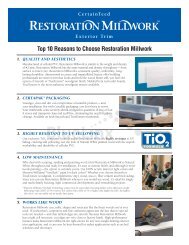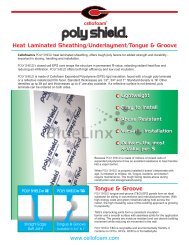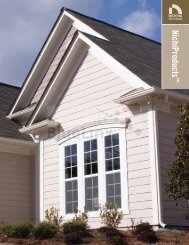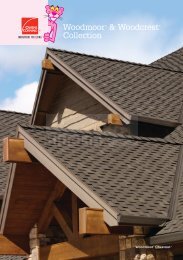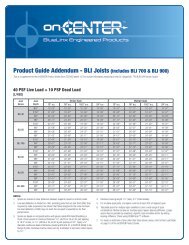Ply Gem Stone Design Guide - BlueLinx
Ply Gem Stone Design Guide - BlueLinx
Ply Gem Stone Design Guide - BlueLinx
- No tags were found...
You also want an ePaper? Increase the reach of your titles
YUMPU automatically turns print PDFs into web optimized ePapers that Google loves.
Frequently Asked QuestionsHow do manufactured stone and natural stone differ?<strong>Ply</strong> <strong>Gem</strong> <strong>Stone</strong> is cast from molds of real stone. This process makes the stonelighter in weight than natural stone. With natural stone, wall ties and footings areoftentimes required, which, in turn, can increase installation cost and difficulty.What are the benefits of using manufactured stone?There are many benefits to using <strong>Ply</strong> <strong>Gem</strong> <strong>Stone</strong> for your next project. Manufacturedstone’s lightweight properties eliminate the need for wall ties or footings. In addition,manufactured stone is about one-third to one-half the cost of natural stone and has a2% waste factor versus an average of 10% with natural stone.Where can <strong>Ply</strong> <strong>Gem</strong> <strong>Stone</strong> be installed?With proper preparation, <strong>Ply</strong> <strong>Gem</strong> <strong>Stone</strong> can be installed to almost any structurallysound surface. Our manufactured stone is ideal for indoor and outdoor applications,buildings of all sizes, commercial or residential. We invite you to visit plygemstone.comfor installation ideas.Who can install <strong>Ply</strong> <strong>Gem</strong> <strong>Stone</strong>?Almost anyone can install our lightweight <strong>Ply</strong> <strong>Gem</strong> <strong>Stone</strong> products. We do, however,recommend a fundamental understanding of stone masonry for the best result. Pleasefollow our installation recommendations, or contact your <strong>Ply</strong> <strong>Gem</strong> <strong>Stone</strong> representativewith any questions.How does <strong>Ply</strong> <strong>Gem</strong> <strong>Stone</strong> hold up to freeze/thaw cycles?<strong>Ply</strong> <strong>Gem</strong> <strong>Stone</strong> products are tested for freeze/thaw durability. We recommend thatyou incorporate adequate building practices, including proper flashing and waterdiversion techniques to help ensure a successful installation and long-lasting result.How much does manufactured stone weigh?<strong>Ply</strong> <strong>Gem</strong> <strong>Stone</strong> recommends that you estimate approximately 10-12 lbs. per squarefoot. Our manufactured stone qualifies as an adhered veneer because it weighs lessthan 15 lbs. per square foot.Will <strong>Ply</strong> <strong>Gem</strong> <strong>Stone</strong> fade?<strong>Ply</strong> <strong>Gem</strong> <strong>Stone</strong> blends the base color throughout with permanent mineral oxidepigments applied and absorbed when the veneer is cast. The color becomes anintegral part of the veneer and, similar to natural stone, there are minimal noticeablecolor changes after years of weathering, similar to natural stone.How important is installation?How your finished stone veneer project ultimately looks is dictated by a number offactors, including how well it is installed. With <strong>Ply</strong> <strong>Gem</strong> <strong>Stone</strong>, careful considerationshould be given to the type of profile and color selected, the stone pattern as itis installed, and the type of grout technique used. Before starting a project, werecommend creating a sample board with the look you desire.Where can I purchase <strong>Ply</strong> <strong>Gem</strong> <strong>Stone</strong>?<strong>Ply</strong> <strong>Gem</strong> <strong>Stone</strong> is available through an authorized dealer network and a number ofhome improvement retail outlets. For a location near you, visit plygemstone.com.How can I contact a professional mason?Your area <strong>Ply</strong> <strong>Gem</strong> <strong>Stone</strong> distributor can recommend local masons who are familiarwith our product lines and installation processes.Can <strong>Ply</strong> <strong>Gem</strong> <strong>Stone</strong> be installed near water?We do not recommend <strong>Ply</strong> <strong>Gem</strong> <strong>Stone</strong> for use below the water line in a pool, fountain,or below grade. We recommend applying a high-quality penetrating and breathablesealer that is either silane or siloxane-based in areas where the stone may be subjectto water.What is the thickness of <strong>Ply</strong> <strong>Gem</strong> <strong>Stone</strong>?Depending on the texture, most stone types are 1.25" to 2" in thickness.What is the R-Value of <strong>Ply</strong> <strong>Gem</strong> <strong>Stone</strong>?The average R-Value of <strong>Ply</strong> <strong>Gem</strong> <strong>Stone</strong> is 0.41 per inch of thickness.How is <strong>Ply</strong> <strong>Gem</strong> <strong>Stone</strong> cleaned?We recommend you try a simple soft bristle brush to remove dirt or other debris. Ifnecessary, try a granulated mild type of detergent mixed with water or a solution of (nomore than) one part white vinegar to five parts water. Rinse with clean water to removeany cleaning solution that might remain on the surface. DO NOT use wire brushes, acidcleaners, power washers, bleach, paint remover, or any other type of concrete cleaner.Can <strong>Ply</strong> <strong>Gem</strong> <strong>Stone</strong> be sealed?Sealing <strong>Ply</strong> <strong>Gem</strong> <strong>Stone</strong> is not required; however, a sealer will provide added protectionand will create a surface that is easier to clean. If you decide to seal your stone veneer,use only a silane or siloxane-based penetrating, breathable masonry sealer. Please notethat you should test a small area beforehand because a sealer may affect stone color.Are movement joints required for <strong>Ply</strong> <strong>Gem</strong> <strong>Stone</strong>?Expansion joints usually pass completely through a wall. Control joints are often placed on thesurface of the wall and relieve strain on the skin of the wall. Terminate the veneer installationwhere control and expansion joints occur in the substrate. Do not span these joints withveneer because this will lead to cracking. Expansion joints in a building must be specified bythe architect or engineer. The architect or engineer should consider the ASTM C 1063 controljoint requirements when determining the location of control joints on any structure. Theweakest point on a wall is usually immediately above and below the penetrations.How is <strong>Ply</strong> <strong>Gem</strong> <strong>Stone</strong> installed when there is an expansion joint?You will need to treat each section as its own installation. Do not span movement jointswith the veneer.What is <strong>Ply</strong> <strong>Gem</strong> <strong>Stone</strong>’s recommendation for flashingaround windows and doors?To maintain the weather-resistance of the exterior wall on which the stoneproducts are installed, a firm and corrosion-resistant flashing should be installedat all penetrations and terminations of the veneer cladding. There should also be ameans of drainage incorporated. Flashing type and locations will need to fall withinaccordance with the requirements of the applicable code. Please refer to ASTM E2112or any information from your window or door manufacturer.32 Frequently Asked Questions




